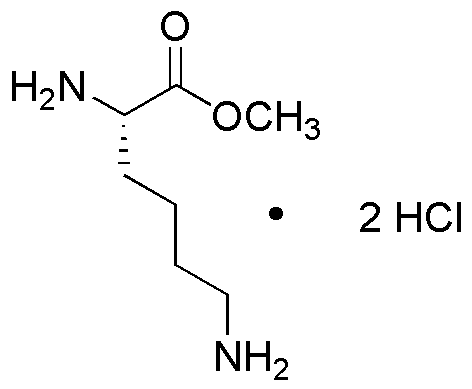L-Lysine methyl ester dihydrochloride is widely utilized in research focused on:
- Pharmaceutical Development: This compound serves as a building block for synthesizing various pharmaceuticals, particularly those targeting metabolic disorders, due to its amino acid structure.
- Nutrition Supplements: It is used in dietary supplements aimed at enhancing muscle growth and recovery, making it popular among athletes and fitness enthusiasts.
- Biochemical Research: Researchers employ this compound in studies related to protein synthesis and enzyme activity, providing insights into cellular processes.
- Cosmetic Formulations: The compound is incorporated into skincare products for its moisturizing properties, benefiting formulations aimed at improving skin hydration.
- Agricultural Applications: It is explored as a potential additive in animal feed to promote growth and improve overall health in livestock, addressing the needs of the agricultural sector.
General Information
Properties
Safety and Regulations
Applications
L-Lysine methyl ester dihydrochloride is widely utilized in research focused on:
- Pharmaceutical Development: This compound serves as a building block for synthesizing various pharmaceuticals, particularly those targeting metabolic disorders, due to its amino acid structure.
- Nutrition Supplements: It is used in dietary supplements aimed at enhancing muscle growth and recovery, making it popular among athletes and fitness enthusiasts.
- Biochemical Research: Researchers employ this compound in studies related to protein synthesis and enzyme activity, providing insights into cellular processes.
- Cosmetic Formulations: The compound is incorporated into skincare products for its moisturizing properties, benefiting formulations aimed at improving skin hydration.
- Agricultural Applications: It is explored as a potential additive in animal feed to promote growth and improve overall health in livestock, addressing the needs of the agricultural sector.
Documents
Safety Data Sheets (SDS)
The SDS provides comprehensive safety information on handling, storage, and disposal of the product.
Product Specification (PS)
The PS provides a comprehensive breakdown of the product’s properties, including chemical composition, physical state, purity, and storage requirements. It also details acceptable quality ranges and the product's intended applications.
Certificates of Analysis (COA)
Search for Certificates of Analysis (COA) by entering the products Lot Number. Lot and Batch Numbers can be found on a product’s label following the words ‘Lot’ or ‘Batch’.
*Catalog Number
*Lot Number
Certificates Of Origin (COO)
This COO confirms the country where the product was manufactured, and also details the materials and components used in it and whether it is derived from natural, synthetic, or other specific sources. This certificate may be required for customs, trade, and regulatory compliance.
*Catalog Number
*Lot Number
Safety Data Sheets (SDS)
The SDS provides comprehensive safety information on handling, storage, and disposal of the product.
DownloadProduct Specification (PS)
The PS provides a comprehensive breakdown of the product’s properties, including chemical composition, physical state, purity, and storage requirements. It also details acceptable quality ranges and the product's intended applications.
DownloadCertificates of Analysis (COA)
Search for Certificates of Analysis (COA) by entering the products Lot Number. Lot and Batch Numbers can be found on a product’s label following the words ‘Lot’ or ‘Batch’.
*Catalog Number
*Lot Number
Certificates Of Origin (COO)
This COO confirms the country where the product was manufactured, and also details the materials and components used in it and whether it is derived from natural, synthetic, or other specific sources. This certificate may be required for customs, trade, and regulatory compliance.


